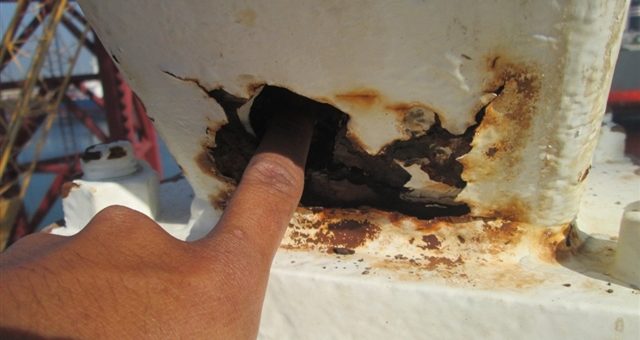IMCA’s attention has been brought to instances of potentially serious corrosion on certain types of derricks on jack up offshore drilling rigs. During the periodical inspection of drilling structures, a significant structural integrity issue has been identified. The derricks affected are mostly all 1.2 – 1.3m hook load or GNC derricks built in the early 1980’s.
The issue discovered is advanced corrosion of load bearing members within hollow section members on certain models of drilling derrick. This corrosion on the derrick members has been shown to be serious enough to affect the performance and therefore the load bearing capacity of these derricks.
In the worst case scenario, there is the potential for member failure which could in turn overload other structural members or create a significant structural failure and/or DROPS incident.
IMCA highlights that corrosion-related failure of materials as an immediate cause of near misses or even actual incidents is something that has come on the spotlight recently and advises operators to pay attention into this matter, particularly where corrosion may be hidden, difficult to access or otherwise likely to be overlooked.
The Incident
During the periodical Inspection of Drilling Structures DSL has identified a significant structural integrity issue on certain types of Dreco Derricks on Jack Up Rigs. The derricks effected are mostly all 1.2 – 1.3m hook load or GNC derricks built in the early 1980’s.
The issue is the advanced corrosion of load bearing members within hollow section members on this model of Dreco drilling derricks is in places of complete “through thickness” of the base material and appears to be prevalent on a particular Dreco model installed on Jack up rigs.
This corrosion on the derrick members is to the extent that this has the ability to affect the performance and therefore the load bearing capacity of these derricks.
In the worst examples of this there is the potential for member failure which could in turn overload other structural members or create a significant structural failure and/or DROPS incident.
A structural analysis of this derrick in its current condition established that the structure was only able to absorb 40% of its original design capacity. The rig owner was unaware of either the corrosion or the potential risk to their operations.
What caused it
The issue is extensive internal corrosion that is not being identified by previous inspections until the base metal has been completely corroded exposing holes in the members.
API 4G Category IV inspection criteria calls for thickness checks of hollow section members, however, API 4G currently states that Cat IV Inspections are not required on offshore structures.
Whilst many offshore drilling contractors have a Cat IV carried out every 5 years, obviously a gap does exist between specification and actual structure. Regardless of these factors, it is obvious that any previous inspections had either not identified or emphasised the criticality of this corrosion.
What can be done
Obviously this issue could be prevalent on other offshore structures that incorporate hollow section and/or tubular members as part of the derrick/mast structure. For instance, in addition to load bearing structural members of the derrick/mast, many racking board support frames to which fingers and monkey boards are attached are often manufactured from hollow section.
We therefore suggest that as part of your forward maintenance/inspection program that drilling structures that are over 10 years old, and/or are due an API 4G Cat IV inspection, are subjected to thickness checks on any tubular/hollow section members, so as to both establish if advanced corrosion is present and developing inside any such members, and that periodical inspections can monitor any further deterioration of the base metal thickness of these components or take the appropriate action such as repairing or replacing any such member in accordance with the relevant specification.
The qualification and competency of the company and inspector that are designated to inspect your drilling structure should also be qualified to do so.
Drill crew should also receive training on undertaking API Cat I & II Inspection of Drilling Structures to further mitigate the possibility of issues like this developing unchecked.
Source: IMCA Safety Flash / Derricksl






























































